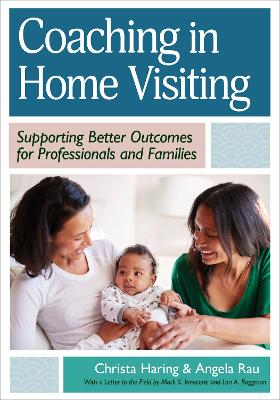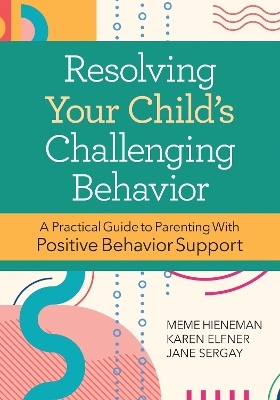Coaching in Home Visiting
 portes grátis
portes grátis
Coaching in Home Visiting
Supporting Better Outcomes for Professionals and Families
Korfmacher, Jon; Haring, Christa; Pyle, Nicole; Rau, Angela; Hemmeter, Mary Louise; Beegle, Rebecca S; Roggman, Lori; Marickovich, Patty; Traube, Dorian; Innocenti, Mark
Brookes Publishing Co
10/2024
240
Mole
9781681257327
15 a 20 dias
Coaching in the Home Visiting Space
Table of Contents
Chapter 1: Introduction to Coaching in the Home Visiting Space
Christa Haring Biel, PhD & Angela Rau, M.S. Director of Program Innovations and Professional Development, Parents as Teachers
Chapter 2: Applying Partnership Principles in Coaching Home Visitors & Caregivers
Jim Knight, PhD, University of Kansas, Director, Kansas Coaching Project
Chapter 3: Culturally Responsive Coaching
Rihana Mason, PhD, Urban Child Study Center, Georgia State University & Lori Bass, PhD
Chapter 4: Reflective Supervision and Coaching
Patricia Marickovich, Senior Program Analyst/MIECHV Coordinator, Office of Head Start
Chapter 5: Developmental Supervision: Coaching Home Visitors and Families Within a Reflective Process
Mark S. Innocenti, PhD, Professor Emeritus, Utah State University & Lori A. Roggman, PhD, Professor Emeritus, Utah State University
Chapter 6: Coaching Caregivers During Early Intervention
Mollie Romano, PhD, Assistant Professor, Florida State University
Chapter 7: Coaching Home Visitors in Early Head Start
Bridget A. Walsh, PhD, Patricia H. Manz, PhD, & Hyun-Joo Jeon
Chapter 8: Coaching Family Life
Kimberly Allen, Debbie Farr, Margaret Machara
Chapter 9: Partnering with Parents
Kimberly Menuir & Joseph Sparling, PhD, Professor Emeritus, University of North Carolina at Chapel Hill
Chapter 10: Effective Feedback Cycles with Families
Christa Haring Biel, PhD, Mirza Lugo-Neris, PhD & Rebecca Beegle, M.S.
Chapter 11: Coaching home visitors and families through virtual home visitation
Dorian E. Traube, PhD, LCSW, USC Suzanne Dworak Peck School of Social Work & Angela Rau, M.S. Director of Program Innovations and Professional Development, Parents as Teachers
Chapter 11: Maintaining fidelity during broad dissemination: An example using the SafeCare parenting model
Daniel Whitaker, PhD, Distinguished University Professor, Associate Dean for Research and Faculty Affairs, Director of National SafeCare Training and Research Center
Chapter 12: Evidence building
Jon Korfmacher
Chapter 1: Introduction to Coaching in the Home Visiting Space
Christa Haring Biel, PhD & Angela Rau, M.S. Director of Program Innovations and Professional Development, Parents as Teachers
* History of coaching
* Defining the construct of coaching
* What does coaching in home visiting look like
* How does coaching in home visiting differ from other types/forms of coaching
* Review of the literature
* Current practice in the field
* Ongoing research
Chapter 2: Applying Partnership Principles in Coaching Home Visitors & Caregivers
Jim Knight, PhD, University of Kansas, Director, Kansas Coaching Project
* Equality
* Dialogue
* Reflection
* Praxis
* Choice
* Voice
* Reciprocity
Chapter 3: Reflective Supervision and Coaching
Patricia Marickovich, Senior Program Analyst/MIECHV Coordinator, Office of Head Start
* Reflective Supervision
o Elements
o Promote Staff Development
* Coaching
o Elements
o Culture of Coaching
* Similarities between Reflective Supervision and Coaching
o Support Staff Development
o Relationship-based
o Strengthen Child and Family Outcomes
o Investing in the Organization's Human Resource System
* Distinctions between Reflective Supervision and Coaching
o Mentor- ProtEgE Relationships in Coaching
o Employee and Supervisors' Roles to Engage Reflective Supervision Practices
? Employee's self-reflection
? Supervisor's Preparation
? Planned Continual Support
Chapter 4: Developmental Supervision: Coaching Home Visitors and Families Within a Reflective Process
Mark S. Innocenti, PhD, Professor Emeritus, Utah State University & Lori A. Roggman, PhD, Professor Emeritus, Utah State University
* Effective coaching is positive, strengths-based, responsive, detailed in feedback, and adapted to the individual, their goals, and their situation.
* Coaching in home visiting is unique in that supervisors' coach practitioners who in turn coach families.
* Coaching requires a set of skills that may come naturally to some but can be learned by most, including accurate observation skills, a focus on positive goal-directed behavior, the ability to verbally describe observations in concrete detail, respectful collaboration, enthusiastic encouragement, and support for making small steps toward goals.
* Multiple roles in home visiting programs-caregiver, home visitor, supervisor/coach-each have specific requirements about the goals and content of what they are coaching, but the process is so similar that we refer to it as "parallel."
* Parallel process means that the approach home visitors use in their work with parents is parallel to the process supervisors/coaches use with home visitors and also parallel with the approach we hope caregivers will use with babies and young children.
* Evidence-based observation tools can guide coaching by indicating which caregiving or supervising interactions occur that link to positive outcomes of home visiting.
* A reflective process allows examination of barriers that interfere with successful implementation of practices.
* Developmental Supervision implementation will be described.
Chapter 5: Coaching Caregivers Using Part C
Mollie Romano, PhD, Assistant Professor, Florida State University
* Individualized coaching that matches the needs of the adult caregiver's goals, priorities for their child and family, and learning style.
o What makes caregiver coaching in Part C unique?
? Individualized (not coaching on a 'curriculum')
? Capacity-building and strengths-based
? Routines-based- the importance of caregiver-child interactions during everyday family-identified routines as part of coaching within home visits
* Use of frameworks for coaching- while coaching should be individualized, we need theoretically grounded, evidence-informed core coaching components within fidelity measures to guide our coaching.
o Early interventionists should incorporate caregiver coaching fidelity measures within their everyday practice.
o Examples of fidelity measures and how they are being used.
* Professional development needs for providers learning to use strengths-based coaching approaches in Early Intervention.
o What is the state of current research?
o What are some new and innovative approaches?
o What are some important future directions?
Chapter 6: Partnering with Parents
Kimberly Menuir & Joseph Sparling, PhD, Professor Emeritus, University of North Carolina at Chapel Hill
* Research shows that using a partnership approach with adult learners creates impactful change
* Building an equitable relationship, where both the home visitor and parents benefit
* Building shared understanding
* Sharing knowledge
* Letting the parent lead
* Scaffolding for success
Chapter 7: Effective Feedback Cycles with Families
Christa Haring Biel, PhD, Mirza Lugo-Neris, PhD & Rebecca Beegle, M.S.
* Identifying the steps of the feedback cycle used in effective coaching
* Coaching conversations that create change
* Identifying areas for improvement
* Language use in effective feedback
* Objective observation
* Modeling
Chapter 8: Culturally Responsive Coaching
Rihana Mason, PhD, Urban Child Study Center, Georgia State University & Lori Bass, PhD
* Honoring cultural practices
* Co-Creating an intervention plan
* Being Sensitive to linguistic differences
* Providing Culturally Sensitive Feedback
Chapter 9: Coaching home visitors and families through virtual home visitation
Dorian E. Traube, PhD, LCSW, USC Suzanne Dworak Peck School of Social Work & Angela Rau, M.S. Director of Program Innovations and Professional Development, Parents as Teachers
* Defining what coaching is in virtual environments
* Coaching across and array of services
* The parallel process of coaching home visitors and families through virtual home visitation
* Definition of the parallel process
* Promoting the power of the client to be self-directing, self-managing, self-monitoring, self-modifying
* There are embedded opportunities for "serve and return" interactions between supervisor and home visitor that can be replicated between home visitor and family
* Coaching is the key to reducing home visitor interference in parent child interaction and empowering parents to lead
* Steps for prepping home visitors for virtual coaching
* Physical setting - background, third space, eye contact
* Technological needs
* Confidentiality
* Steps for prepping families for virtual coaching
* Physical setting
* Technological needs
* Confidentiality
* Personal Safety and family choice
* Activities to support virtual coaching
* Supervision activities
* Parent child interaction activities
* Goal setting and problem solving with families
* Resource Sharing
* How virtual coaching can support an array of family support services.
* On ground services
* Other telehealth services
Chapter 10: Coaching Home Visitors in Early Head Start
Bridget A. Walsh, PhD, Patricia H. Manz, PhD, & Hyun-Joo Jeon
Coaching is distinct but complementary to other professional development approaches. There is a growing evidence-based approach for other fields but deliberate attention to coaching home visitors is lacking. Coaching home visitors must address the reciprocal relationships of wellness and practice. The authors will describe key recommendations from the transdisciplinary coaching research and the nascent literature on coaching home visitors. The authors will underscore key elements from research-based coaching approaches that emphasize wellness and promotion development. Defining features from models, such as Family Life Coaching and Family Life Education (Allen & Huff, 2014; Myers-Walls et al., 2011; Walsh et al., in press, Walsh et al., 2020ab), Reflective Supervision/Consultation (Susman-Stillman et al., 2020; Watson et al., 2014), and Performance-Based Coaching (Krick Oborn & Johnson, 2015; Snyder et al., 2015; Manz et al., 2017) will be underscored.
Strategies that are intended to promote home visitor well-being in coaching will be described. Examples of coaching strategies include:
* goal setting
* empathy
* empower
* appreciative inquiry
* open-ended questions
* best possible self- visualization
* self-care
* self-awareness
* self-compassion break
* cognitive restructuring
Chapter 11: Maintenance of fidelity during broad dissemination: An example using the SafeCare parenting model
Daniel Whitaker, PhD, Distinguished University Professor, Associate Dean for Research and Faculty Affairs, Director of National SafeCare Training and Research Center
SafeCare is an evidence-based behavioral parenting program used in both preventive settings and by child welfare systems. It has been disseminated in over 30 US states and several non-US countries. A key to successful dissemination of any model is the implementation of processes to ensure fidelity to the model is maintained over time. The National SafeCare Training and Research Center, which disseminates SafeCare, has developed procedures to do this while disseminating SafeCare. This chapter will have several goals:
* Briefly describe the SafeCare parenting model and summarize its evidence
* Describe the NSTRC's implementation model for SafeCare
* Describe how fidelity to the SafeCare model is measured. This section will include a discussion of fidelity measurement methods and concepts.
* Describe processes put into place by NSTRC to facilitate the ongoing assessment of fidelity. This section will include ongoing challenges to fidelity measurement.
* Present summary data from years of accruing data on fidelity to the SafeCare model. (note: we are still working on summarizing this data and have a dissertation in progress on it; not 100% sure we will be able to include the data depending on publication issues).
Coaching in the Home Visiting Space
Table of Contents
Chapter 1: Introduction to Coaching in the Home Visiting Space
Christa Haring Biel, PhD & Angela Rau, M.S. Director of Program Innovations and Professional Development, Parents as Teachers
Chapter 2: Applying Partnership Principles in Coaching Home Visitors & Caregivers
Jim Knight, PhD, University of Kansas, Director, Kansas Coaching Project
Chapter 3: Culturally Responsive Coaching
Rihana Mason, PhD, Urban Child Study Center, Georgia State University & Lori Bass, PhD
Chapter 4: Reflective Supervision and Coaching
Patricia Marickovich, Senior Program Analyst/MIECHV Coordinator, Office of Head Start
Chapter 5: Developmental Supervision: Coaching Home Visitors and Families Within a Reflective Process
Mark S. Innocenti, PhD, Professor Emeritus, Utah State University & Lori A. Roggman, PhD, Professor Emeritus, Utah State University
Chapter 6: Coaching Caregivers During Early Intervention
Mollie Romano, PhD, Assistant Professor, Florida State University
Chapter 7: Coaching Home Visitors in Early Head Start
Bridget A. Walsh, PhD, Patricia H. Manz, PhD, & Hyun-Joo Jeon
Chapter 8: Coaching Family Life
Kimberly Allen, Debbie Farr, Margaret Machara
Chapter 9: Partnering with Parents
Kimberly Menuir & Joseph Sparling, PhD, Professor Emeritus, University of North Carolina at Chapel Hill
Chapter 10: Effective Feedback Cycles with Families
Christa Haring Biel, PhD, Mirza Lugo-Neris, PhD & Rebecca Beegle, M.S.
Chapter 11: Coaching home visitors and families through virtual home visitation
Dorian E. Traube, PhD, LCSW, USC Suzanne Dworak Peck School of Social Work & Angela Rau, M.S. Director of Program Innovations and Professional Development, Parents as Teachers
Chapter 11: Maintaining fidelity during broad dissemination: An example using the SafeCare parenting model
Daniel Whitaker, PhD, Distinguished University Professor, Associate Dean for Research and Faculty Affairs, Director of National SafeCare Training and Research Center
Chapter 12: Evidence building
Jon Korfmacher
Chapter 1: Introduction to Coaching in the Home Visiting Space
Christa Haring Biel, PhD & Angela Rau, M.S. Director of Program Innovations and Professional Development, Parents as Teachers
* History of coaching
* Defining the construct of coaching
* What does coaching in home visiting look like
* How does coaching in home visiting differ from other types/forms of coaching
* Review of the literature
* Current practice in the field
* Ongoing research
Chapter 2: Applying Partnership Principles in Coaching Home Visitors & Caregivers
Jim Knight, PhD, University of Kansas, Director, Kansas Coaching Project
* Equality
* Dialogue
* Reflection
* Praxis
* Choice
* Voice
* Reciprocity
Chapter 3: Reflective Supervision and Coaching
Patricia Marickovich, Senior Program Analyst/MIECHV Coordinator, Office of Head Start
* Reflective Supervision
o Elements
o Promote Staff Development
* Coaching
o Elements
o Culture of Coaching
* Similarities between Reflective Supervision and Coaching
o Support Staff Development
o Relationship-based
o Strengthen Child and Family Outcomes
o Investing in the Organization's Human Resource System
* Distinctions between Reflective Supervision and Coaching
o Mentor- ProtEgE Relationships in Coaching
o Employee and Supervisors' Roles to Engage Reflective Supervision Practices
? Employee's self-reflection
? Supervisor's Preparation
? Planned Continual Support
Chapter 4: Developmental Supervision: Coaching Home Visitors and Families Within a Reflective Process
Mark S. Innocenti, PhD, Professor Emeritus, Utah State University & Lori A. Roggman, PhD, Professor Emeritus, Utah State University
* Effective coaching is positive, strengths-based, responsive, detailed in feedback, and adapted to the individual, their goals, and their situation.
* Coaching in home visiting is unique in that supervisors' coach practitioners who in turn coach families.
* Coaching requires a set of skills that may come naturally to some but can be learned by most, including accurate observation skills, a focus on positive goal-directed behavior, the ability to verbally describe observations in concrete detail, respectful collaboration, enthusiastic encouragement, and support for making small steps toward goals.
* Multiple roles in home visiting programs-caregiver, home visitor, supervisor/coach-each have specific requirements about the goals and content of what they are coaching, but the process is so similar that we refer to it as "parallel."
* Parallel process means that the approach home visitors use in their work with parents is parallel to the process supervisors/coaches use with home visitors and also parallel with the approach we hope caregivers will use with babies and young children.
* Evidence-based observation tools can guide coaching by indicating which caregiving or supervising interactions occur that link to positive outcomes of home visiting.
* A reflective process allows examination of barriers that interfere with successful implementation of practices.
* Developmental Supervision implementation will be described.
Chapter 5: Coaching Caregivers Using Part C
Mollie Romano, PhD, Assistant Professor, Florida State University
* Individualized coaching that matches the needs of the adult caregiver's goals, priorities for their child and family, and learning style.
o What makes caregiver coaching in Part C unique?
? Individualized (not coaching on a 'curriculum')
? Capacity-building and strengths-based
? Routines-based- the importance of caregiver-child interactions during everyday family-identified routines as part of coaching within home visits
* Use of frameworks for coaching- while coaching should be individualized, we need theoretically grounded, evidence-informed core coaching components within fidelity measures to guide our coaching.
o Early interventionists should incorporate caregiver coaching fidelity measures within their everyday practice.
o Examples of fidelity measures and how they are being used.
* Professional development needs for providers learning to use strengths-based coaching approaches in Early Intervention.
o What is the state of current research?
o What are some new and innovative approaches?
o What are some important future directions?
Chapter 6: Partnering with Parents
Kimberly Menuir & Joseph Sparling, PhD, Professor Emeritus, University of North Carolina at Chapel Hill
* Research shows that using a partnership approach with adult learners creates impactful change
* Building an equitable relationship, where both the home visitor and parents benefit
* Building shared understanding
* Sharing knowledge
* Letting the parent lead
* Scaffolding for success
Chapter 7: Effective Feedback Cycles with Families
Christa Haring Biel, PhD, Mirza Lugo-Neris, PhD & Rebecca Beegle, M.S.
* Identifying the steps of the feedback cycle used in effective coaching
* Coaching conversations that create change
* Identifying areas for improvement
* Language use in effective feedback
* Objective observation
* Modeling
Chapter 8: Culturally Responsive Coaching
Rihana Mason, PhD, Urban Child Study Center, Georgia State University & Lori Bass, PhD
* Honoring cultural practices
* Co-Creating an intervention plan
* Being Sensitive to linguistic differences
* Providing Culturally Sensitive Feedback
Chapter 9: Coaching home visitors and families through virtual home visitation
Dorian E. Traube, PhD, LCSW, USC Suzanne Dworak Peck School of Social Work & Angela Rau, M.S. Director of Program Innovations and Professional Development, Parents as Teachers
* Defining what coaching is in virtual environments
* Coaching across and array of services
* The parallel process of coaching home visitors and families through virtual home visitation
* Definition of the parallel process
* Promoting the power of the client to be self-directing, self-managing, self-monitoring, self-modifying
* There are embedded opportunities for "serve and return" interactions between supervisor and home visitor that can be replicated between home visitor and family
* Coaching is the key to reducing home visitor interference in parent child interaction and empowering parents to lead
* Steps for prepping home visitors for virtual coaching
* Physical setting - background, third space, eye contact
* Technological needs
* Confidentiality
* Steps for prepping families for virtual coaching
* Physical setting
* Technological needs
* Confidentiality
* Personal Safety and family choice
* Activities to support virtual coaching
* Supervision activities
* Parent child interaction activities
* Goal setting and problem solving with families
* Resource Sharing
* How virtual coaching can support an array of family support services.
* On ground services
* Other telehealth services
Chapter 10: Coaching Home Visitors in Early Head Start
Bridget A. Walsh, PhD, Patricia H. Manz, PhD, & Hyun-Joo Jeon
Coaching is distinct but complementary to other professional development approaches. There is a growing evidence-based approach for other fields but deliberate attention to coaching home visitors is lacking. Coaching home visitors must address the reciprocal relationships of wellness and practice. The authors will describe key recommendations from the transdisciplinary coaching research and the nascent literature on coaching home visitors. The authors will underscore key elements from research-based coaching approaches that emphasize wellness and promotion development. Defining features from models, such as Family Life Coaching and Family Life Education (Allen & Huff, 2014; Myers-Walls et al., 2011; Walsh et al., in press, Walsh et al., 2020ab), Reflective Supervision/Consultation (Susman-Stillman et al., 2020; Watson et al., 2014), and Performance-Based Coaching (Krick Oborn & Johnson, 2015; Snyder et al., 2015; Manz et al., 2017) will be underscored.
Strategies that are intended to promote home visitor well-being in coaching will be described. Examples of coaching strategies include:
* goal setting
* empathy
* empower
* appreciative inquiry
* open-ended questions
* best possible self- visualization
* self-care
* self-awareness
* self-compassion break
* cognitive restructuring
Chapter 11: Maintenance of fidelity during broad dissemination: An example using the SafeCare parenting model
Daniel Whitaker, PhD, Distinguished University Professor, Associate Dean for Research and Faculty Affairs, Director of National SafeCare Training and Research Center
SafeCare is an evidence-based behavioral parenting program used in both preventive settings and by child welfare systems. It has been disseminated in over 30 US states and several non-US countries. A key to successful dissemination of any model is the implementation of processes to ensure fidelity to the model is maintained over time. The National SafeCare Training and Research Center, which disseminates SafeCare, has developed procedures to do this while disseminating SafeCare. This chapter will have several goals:
* Briefly describe the SafeCare parenting model and summarize its evidence
* Describe the NSTRC's implementation model for SafeCare
* Describe how fidelity to the SafeCare model is measured. This section will include a discussion of fidelity measurement methods and concepts.
* Describe processes put into place by NSTRC to facilitate the ongoing assessment of fidelity. This section will include ongoing challenges to fidelity measurement.
* Present summary data from years of accruing data on fidelity to the SafeCare model. (note: we are still working on summarizing this data and have a dissertation in progress on it; not 100% sure we will be able to include the data depending on publication issues).







